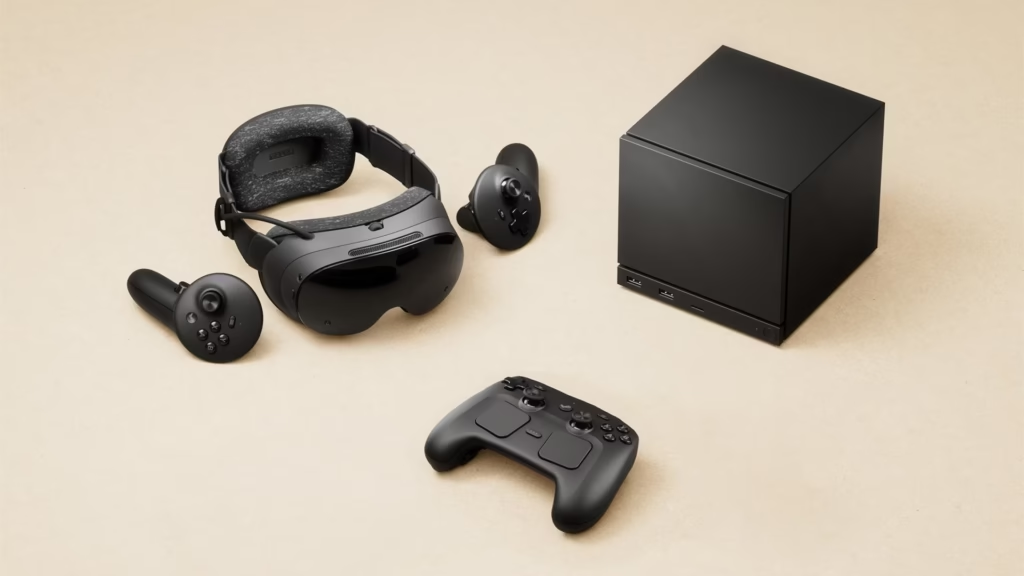YTC Ventures | Technocrat’ Magazine
November 13, 2025
In a bombshell announcement that’s sending shockwaves through the gaming industry, Valve Corporation – the powerhouse behind the Steam platform – has officially revealed the Steam Machine, a compact 6-inch cubical console designed to bring high-end PC gaming to your living room TV.
Launching in early 2026, this isn’t just another mini-PC; it’s positioned as a direct rival to Sony’s PlayStation 5 and Microsoft’s Xbox Series X/S, boasting over 6x the power of the wildly successful Steam Deck handheld.
Powered by a semi-custom AMD Zen 4 CPU, RDNA 3 GPU with 28 Compute Units, 16GB RAM 16GB RAM, and options for 512GB or 2TB SSD storage, the Steam Machine promises 4K gaming at 60 FPS with FSR upscaling, ray tracing support, and whisper-quiet operation.
Running Valve’s Linux-based SteamOS out of the box (with easy Windows installability), it accesses your entire Steam library – over 100,000 games – while supporting Xbox and PlayStation controllers.

A redesigned Steam Controller with TMR thumbsticks (drift-resistant) and trackpads completes the package, available standalone or bundled.Valve’s bold move revives the “Steam Machine” name from a failed 2015 experiment, but this time, lessons from Steam Deck’s success (millions sold) and matured SteamOS tech make it a credible threat. “PC gamers have continued asking for even more ways to play all the great titles in their Steam libraries,” said Valve President Gabe Newell. Pricing remains TBA, but analysts speculate $499–$699 to compete aggressively.
Valve’s Steam Machine Business Model: Profit from Games, Not Hardware
Unlike traditional console makers who sell hardware at a loss (e.g., PS5/Xbox often ~$100–$200 below cost) and recoup via 30% game royalties, Valve flips the script. Expect the Steam Machine at or near cost – similar to Steam Deck’s “painful but critical” $399 launch pricing – to drive adoption of SteamOS and flood the ecosystem with users.

Valve’s core revenue (90%+) comes from Steam’s 30% cut on every game, DLC, microtransaction, and in-game purchase across its 40M+ daily active users. No subscriptions required – own your library forever. This “razor-and-blades” model mirrors printers (cheap hardware, pricey ink) but with Valve’s massive storefront as the blade. Success amplifies Steam sales; failure costs little. Steam Deck proved it: niche hit, but library access boosted platform revenue.
Console Profits: Sony Leads Revenue, Nintendo Wins Margins
Console giants lose money on hardware (~$100–$200/unit subsidized) but profit massively from software/services (30% royalties + subs). Here’s a snapshot:
| Company | Gaming Revenue (2023 CY, ~USD Bn) | Operating Profit (Recent FY, ~USD Bn) | Notes |
|---|---|---|---|
| Sony (PlayStation) | 30 | 1.8–2.6 | Highest revenue; PS5 sales strong, but acquisitions (e.g., Bungie) hit margins. |
| Microsoft (Xbox) | 18 | ~2 (est. post-ABK) | Game Pass subs shine; hardware always at loss. |
| Nintendo | 12 | 3.8 | Profitable hardware (Switch day-one); top margins. |
Sony dominates revenue via volume; Nintendo excels in profits (hardware profits + software). Microsoft focuses services (Game Pass: $5.5B projected 2025).
Top 5 Console Companies by Market Share/Revenue (2025)
| Rank | Company | Console Market Share | Gaming Revenue (~2025, USD Bn) |
|---|---|---|---|
| 1 | Sony (PlayStation) | 45% | 31+ |
| 2 | Nintendo | 27% | 12–15 |
| 3 | Microsoft (Xbox) | 23% | 18+ |
| 4 | Valve (Steam Deck/Machine) | Emerging (~5% projected) | Steam: 10+ Bn (platform) |
| 5 | Others (Asus, Logitech, etc.) | 5% | N/A |
Sony leads; Valve’s entry could erode Xbox/PC hybrids.
Steam Machine Market Potential: India, Asia, China
India: Console market ~$180–200M (2025), growing 1–5% CAGR; PlayStation dominates (70% share). Mobile/PC rule (89% gamers), but rising incomes/esports (1.5M players) open doors. Steam Machine’s affordability could penetrate urban youth.
Asia-Pacific: ~$14–26B console market (2025), 47% global share. High growth (7–9% CAGR); urbanization/5G fuel demand.China: ~$5.7B by 2033 (3.9% CAGR); regulated but booming post-2015 ban lift. PS/Nintendo lead; Steam Machine ships where Deck does (incl. Asia partners).

Trending Console Games (2025 Buzz)
X/Twitter erupts over Steam Machine, but hits like GTA VI (hype king), Black Myth: Wukong (China smash), Switch 2 exclusives trend. Battle royales/shooters dominate playtime (28%).
Past Years’ Top 10 Best-Selling Console Games (All-Time Units)
| Rank | Game | Units Sold (M) | Platform(s) |
|---|---|---|---|
| 1 | Minecraft | 300+ | Multi |
| 2 | GTA V | 200+ | Multi |
| 3 | Wii Sports | 82.9 | Wii |
| 4 | PUBG | 75 | Multi |
| 5 | Mario Kart 8 | 70+ | Wii U/Switch |
| 6 | Red Dead Redemption 2 | 67 | Multi |
| 7 | Skyrim | 60+ | Multi |
| 8 | TERA | 52? (est.) | Multi |
| 9-10 | Pokemon Titles (Red/Blue/Yellow) | 47+ | GB/3DS |
Bundled/persistent sellers dominate.
Top Gaming Companies & Game Engines (2025)

Top Companies by Revenue:
- Sony Interactive (~$31B)
- Tencent (~$30B+)
- Microsoft Gaming (~$18–21B)
- Nintendo (~$12–15B)
- Apple/Google (mobile stores)
Top Game Engines:
- Unreal Engine 5: AAA visuals (Nanite/Lumen); 5% royalty post-$1M.
- Unity: Versatile, mobile/2D king; free <$200K revenue.
- Godot: Free/open-source; rising for indies/2D.
Valve’s Steam Machine isn’t just hardware – it’s an ecosystem killer. With Steam’s library and no-lockin model, 2026 could redefine consoles.
Stay tuned for pricing and pre-orders.

Comments